Today is, of course, election day in the United States. Here is a post with some random thoughts.
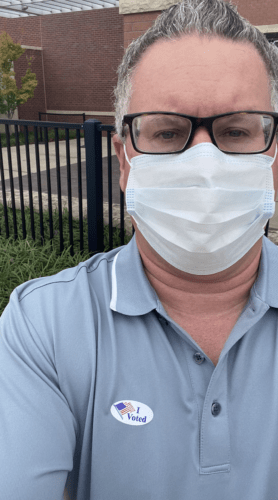
I was fortunate in that I was able to vote in person, early in Texas last month (that is my permanent home and address).
I might look unhappy about it… I am not great at taking selfies, so I'm always somewhat flummoxed by my camera.
I was VERY happy to vote. I'm happy to have that right. I'm fortunate that my right to vote was not suppressed — in a direct or indirect way.
I was able to vote without standing in a line. I had zero wait. I hope the rest of you were/are able to vote without a long wait. A fair and just system would use queuing theory and Lean principles (including “takt time”) to make sure that there is enough voting capacity for everybody to vote in person on voting day. I'd rather see too much capacity than not enough. If we're serious about democracy (ok, it's a representative republic I realize), then we would pay that “price of freedom” and not be cheap about ensuring proper voting capacity with reasonable flow.
A few of the articles about long waits that I found when I wrote this on Sunday Nov. 1:
- Determined voters endure long lines to cast early ballots in historic election
- Long lines, other issues plague early voting in New York City, prompting calls of voter suppression
- Why Are Lines at Polling Places So Long? Math — It's a resource allocation problem, a tough challenge in “queueing theory.” It's also racism.
I'm glad that we are able to “level load” voting by allowing early voting through various methods. That helps the potential capacity crunch and I'm sure we'll see news stories today about long lines. Spreading out the voting and allowing voting by mail seem like especially important countermeasures in a pandemic year when we don't want to ask people to risk their health in the name of voting.
I hope your vote is not thrown out through a technicality or as the result of a partisan law suit. The Lean adage of “respect for people,” to me, means that each person's vote should be counted. Respect also means not intentionally cheating the system, one way or another.
Votes that were received on time need to be counted. In some states, they are not allowed to “level load” the ballot processing or the vote counting (see this article):
“In most states, ballot processing precedes ballot counting. Processing can involve steps such as verifying signatures or checking photocopies of identification documents, depending on the state. In some states, processing may include scanning ballots, but not tabulating them until counting can begin.
States that start processing votes earlier may be able to avoid ballot-counting backlog, which could delay final results for days after next Tuesday's election. But some states don't start processing votes until Election Day, including the all-important battlegrounds of Pennsylvania and Wisconsin.“
Why not start tabulating what comes in early? Maybe officials and lawmakers are worried that early results might get leaked. But how would that be any different than the constant polling numbers that are released?
The President is INCORRECT when he says it's improper to continue counting votes beyond November 3rd. He's ignorant or he's gaslighting people. That's the facts. Read more.
If you are the victim of voter suppression or suspect that it's happening, call 866-OUR-VOTE or visit 866OURVOTE.org to defend your right to VOTE! That's also a good website for learning about your rights and how things work in your state.
The Polling Place — Masks, Process, etc.
Voting was a different process for me this time, with different technology. There were different voting machine consoles… not spaced six feet apart, which surprised me. The machines were right next to each other. I was wearing a mask and I hope that was an enforced requirement. There was a sign… but was it enforced?
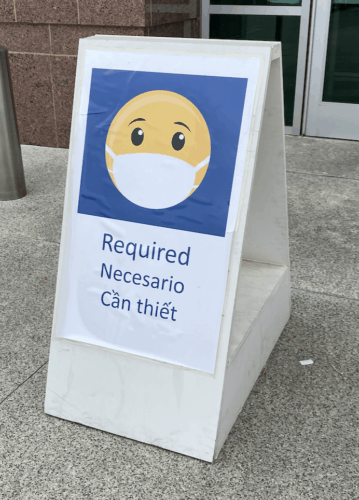
In my view, your right to vote doesn't extend a a right for you to potentially spread germs to me or others. I believe in the doctrine that says you have the right to do whatever you want with your fists, but your rights end at the beginning of my nose.
Not wearing a mask doesn't just expose the non-wearer to risks they might be willing to accept. Not wearing a mask potentially exposes OTHERS to risks they did NOT sign up for. Please don't confuse liberty and selfishness.
From a recent article that resonated with me:
One of the key authors of the Western concept of freedom is John Stuart Mill. In “On Liberty,” he wrote that liberty (or freedom) means “doing as we like, subject to such consequences as may follow, without impediment from our fellow creatures, as long as what we do does not harm them even though they should think our conduct foolish, perverse or wrong.”
Note the clause “as long as what we do does not harm them.” He tossed that in there almost as a given — indeed, it is a given. This is a standard definition of freedom, more colloquially expressed in the adage “Your freedom to do as you please with your fist ends where my jaw begins.”
Now, conservatives revere Mill. But today, in the age of the pandemic, Mill and other conservative heroes like John Locke would be aghast at the way the American right wing bandies about the word “freedom.”
Freedom emphatically does not include the freedom to get someone else sick.
But back to the machines… in the past, I have voted on electronic machines that have had a strange user interface that included a weird scroll wheel.
This time, on my way to the machine, I was told “take one of those pieces of paper.” Um, what? I guess that legal size (?) sheet of paper on the table is a ballot. I was told to load the paper into the machine, as if you were feeding it into a scanner. It went in part way (was this correct? it seemed correct).
The voting was done by touching the screen (better than the wheel, I think). Then, the machine printed my choices on the paper. I then had to take the paper and feed it into a scanner that was on top of a huge black plastic container. I'm glad it was a scanner (for a paper trail) and not shredder.
It's not shredded. It's put into a vault to be counted on Election Day.
— Texas Election Protection (@TXElectionProt) October 17, 2020
Because the polling place “system” wasn't very heavily loaded with voters, there was no wait to use a scanner, thankfully. There were fewer scanners than voting machines. I hope somebody did the math on the right number of scanners based on the time spent voting and the time required to scan.
If there aren't enough scanners, that creates a possible bottleneck… and then, instead of potentially standing in a properly-distanced outdoor queue to get in, you'd be probably crowded with other people waiting inside. I'm making up numbers since I couldn't take photos in there, but there might have been 16 voting machines and three scanners. If it was really busy, how would the queue form for the scanners? Would that be the world's worst freeway merge?
So Much Early Voting — And So Much Voting, in General?
I heard in a news report that this year's election will see MORE early or absentee votes cast than we'll see votes cast in person on Election Day. It's been more like Election MONTH.
The report said over 90 million Americans have already voted early. This report from Monday said it's 100 million.
This was especially true in Texas:
Roughly 57% of registered voters in the state voted early as of Saturday, shattering previous turnout records with one day of voting ahead. The 9.6 million Texans voting early was a 47% increase from the number of early voters in the 2016 general election. from the number of early voters in the 2016 general election. About 735,000 more people voted early this year in Texas than voted in the entire 2016 presidential election, including on Election Day.
You know, if you're a regular reader, that I don't like two-data-point comparisons. It feels like those numbers might be statistical signals, but we'd want to look at more data to be sure.
I wrote a blog post about the statistical “signal” that we saw in the 2018 “midterm” elections being high enough that it was worth trying to explain:
For one, Gov. Greg Abbott expanded early voting in the state by six days to alleviate crowding at polling places amid the coronavirus pandemic, creating more opportunities for Texans to cast their ballots. And the early vote as a share of the overall vote has been growing every election for years.
Is there a trend? We'd want to “plot the dots” to confirm this visually and with Process Behavior Chart rules. #PlotTheDots
We could do a similar analysis based on the % voter turnout for Presidential Election years. That data is available up through 2016. What turnout in 2020 would be a signal?
The United States Election Project has useful and interesting run charts:
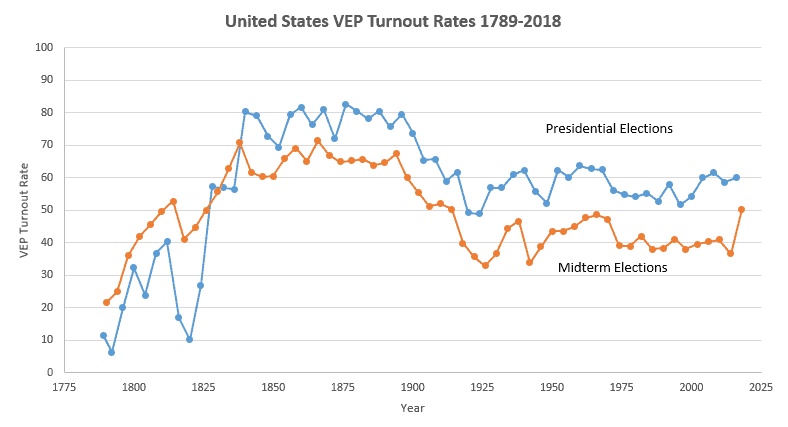
You can see a number of “shifts” in the numbers over time (probably correlating with women getting the right to vote in 1920 and the Voting Rights Act of 1965 — although that law didn't eliminate voter suppression).
Let's try creating a Process Behavior Chart with data from 1928 on, the Presidential Election years only. The run chart shows how the midterm elections are most definitely a different “system” and we shouldn't lump the two data sets together.
The PBC looks like this from 1928 to 2016.
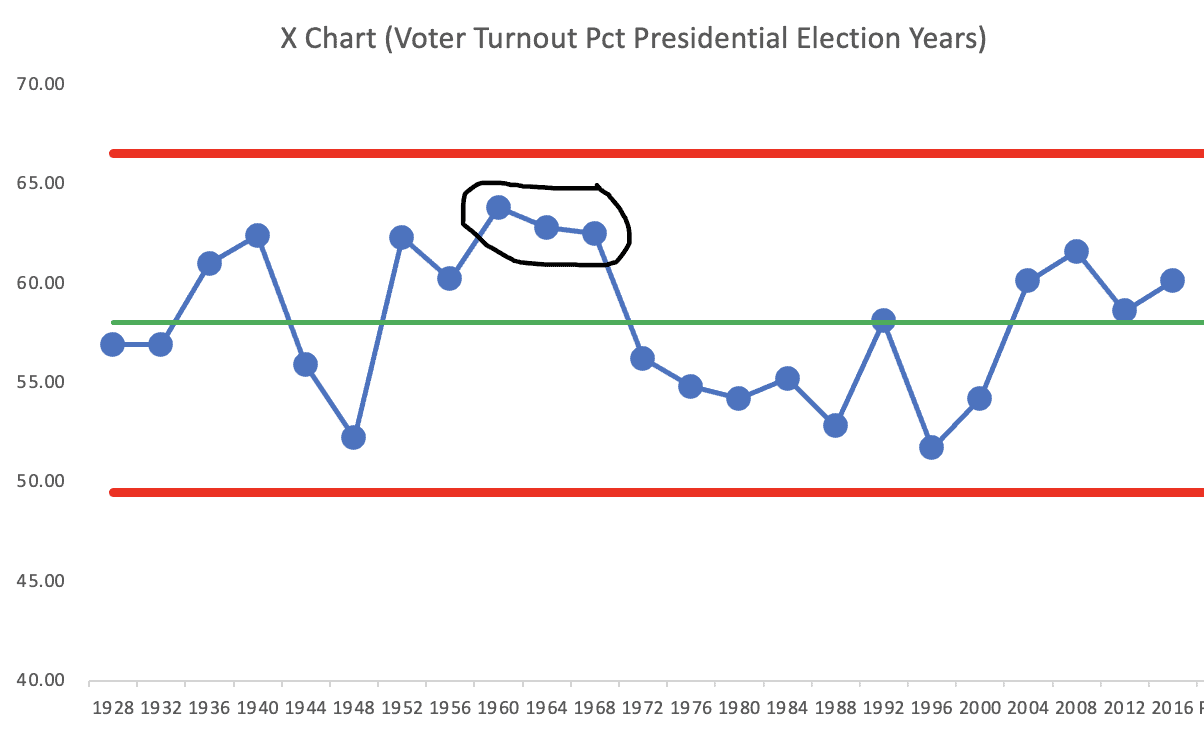
It's a “predictable system” with the exception of one signal…. the three data points circled in black. Those are closer to the calculated Upper Limit than they are to the Average. Was there a reason that voter turnout was relatively high those three elections? The importance of the elections during the peak of the Cold War?
The past four years have been “above average” but that's not worth explaining. That's not a statistical signal (eight consecutive years would be a signal). We ALMOST had a run of eight consecutive below average turnouts from 1972 to 2000. The 1992 number is “smidge” above the average… did voter turnout fall due to disillusionment (due to the Vietnam War?) and then picked up again after 9/11?
The calculated Upper Limit for that chart, above, is 66.56% — voter turnout in 2020 above that number WOULD be a statistical signal. I'd leave it to the political scientists and the pundits to explain why (or we might all have our own theories that would be difficult to prove).
Even if we use just the last four years as a “21st century system,” the limits would look like the following (and four data points is the least number of data points you'd want to use to calculate limits and it's not as good as having 20 or so data points):
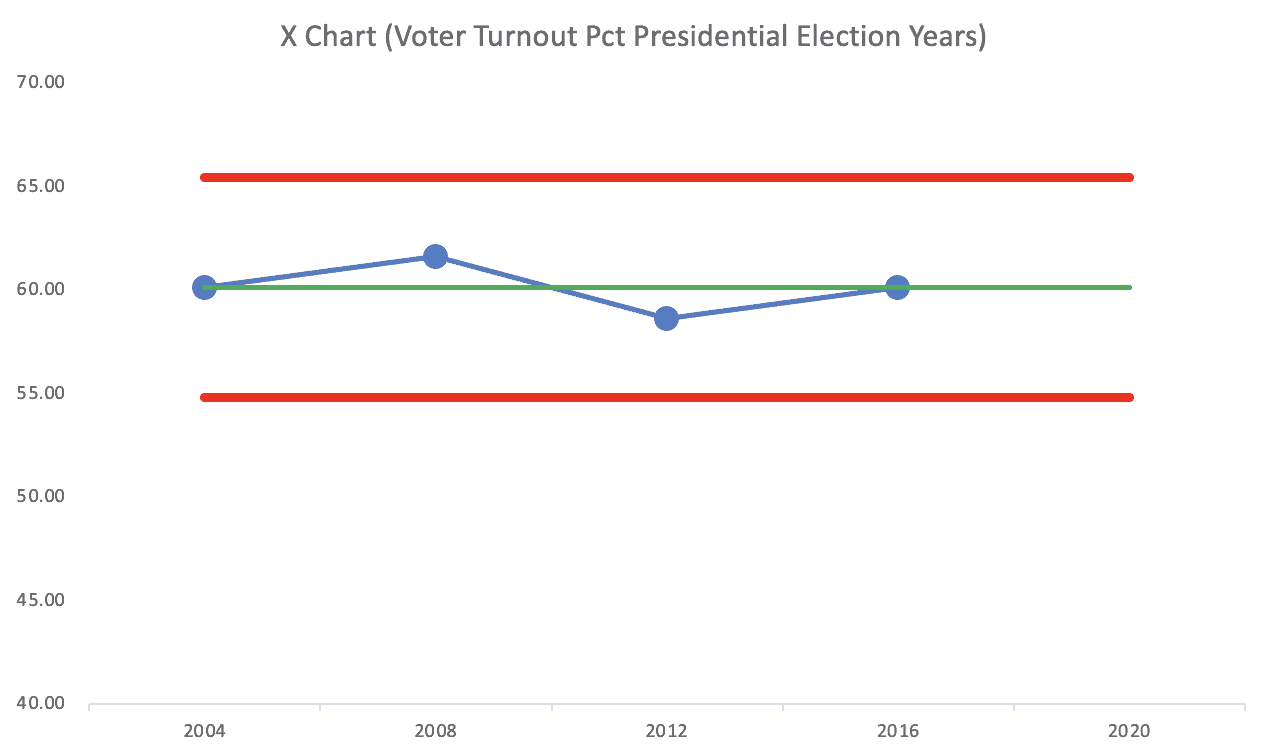
The Upper Limit is calculated as 65.42% — almost the same. Anything at 66% voter turnout or higher would be a statistical signal. That's more valid, statistically, than saying something like, “It's the highest voter turnout this century” or “It's the highest since 1960.”
A turnout of 64%… technically not a signal. It wouldn't be worth explaining… but the pundits would try anyway, since the media loves explaining every up and down, which is more like “statistical illiteracy” than it is “fake news.”
Please Vote — Or Thank You for Voting!
There are many opportunities for improving processes and systems related to voting. I hope that our future elections bring us countermeasures to any problems that were faced here in 2020.
Please vote. If you've already voted, thank you.
Please scroll down (or click) to post a comment. Connect with me on LinkedIn.
Let’s work together to build a culture of continuous improvement and psychological safety. If you're a leader looking to create lasting change—not just projects—I help organizations:
- Engage people at all levels in sustainable improvement
- Shift from fear of mistakes to learning from them
- Apply Lean thinking in practical, people-centered ways
Interested in coaching or a keynote talk? Let’s start a conversation.










Some safety tips from the Surgeon General:
Ten Tips from P.R. Expert Peter Shankman… I’ll have trouble following some of these.
10) Drink a lot of water, throughout the day.
9) Get some physical activity in. Walk. Run. Cycle. Anything.
8) Call a friend and talk about anything BUT the election.
7) Find an animal and play with it. Either yours, a neighbor’s, or at a shelter.
6) Stop doomscrolling.
5) Go to bed at a reasonable hour. The news will still be there when you wake up.
4) Shut off your phone when you go to bed, otherwise you’ll look at it all night.
3) Take deep breaths throughout the day.
2) Practice mindfullness and stay grounded.
1) Be kind. Everyone in our country has an Excederin-sized headache today.
Hi Mark. I can’t say it comes as a shock to see a lean thinker vote over a month early to help the strain on capacity come Nov 3rd. I’d like to say that I also did the same by mailing in my ballot three weeks ago. Unfortunately, I happen to live in Pennsylvania, so odds are I am just contributing to that 3-4 day delay in knowing PA’s results (still unknown as of Wednesday night).
Over the last few months I’ve gotten especially interested in the election from a supply chain and logistics perspective. I think you ask a lot of really good questions regarding the inability to process ballots- I had no idea that processing and counting were two different actions. Lastly: John Stuart’s definition of freedom.. more people need to understand that with masks. Thank you for sharing! -Nick Longman
Thanks for voting, Nick!
I heard a news story today that said the PA mail ballots had to sit unopened until yesterday. The ballots sitting so long, heavily creased, in an envelope for a month led to a number of scanning machine jams… ah, operations.
News link
Turnout is projected to be 66.3% — a signal.
2020 turnout is on pace to break century-old records
Hello Mark-
This article summed up the crazy and very different election day for all of us. I personally mailed in my vote in the state of Massachusetts so I did not see what it looked like to go vote in person, so this article was very helpful to see what people endured on that day. This election showed many bottlenecks, and the bottlenecks differed in each state. Hopefully after seeing these bottlenecks, the process will be thought out more thoroughly and we will be more prepared for the next election if Covid is still largely present. Before this election, I did not look at it from a supply chain or lean thinker perspective, but this article really changed my perspective on the topic and now has me questioning a lot! Thanks for sharing!
Hi Abigail – Thanks for reading the post and for commenting. I certainly hope there are process improvement opportunities that turn into improvements for future elections. What would you have improved about the mail-in voting process that you experienced?